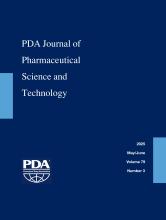Abstract
The sterility of drug products intended for parenteral administration is a critical quality attribute (CQA) because it serves to ensure patient safety, and is thus a key requirement by health authorities. Whilst sterility testing is a probabilistic test, the assurance of sterility is a holistic concept including adequate design of manufacturing facilities, process performance, and product design. Container closure integrity testing (CCIT) is necessary to confirm the integrity of a container closure system (CCS), until the end of a products’s shelf life. The new and revised United States Pharmacopeia (USP) informational chapter <1207> is a comprehensive guidance on CCI. Nevertheless, practical considerations including the choice of CCIT methods, the acceptance criteria, or the positive control samples (artificial leaks) must be addressed by the pharmaceutical manufacturer. This study is the first to provide a systematic comparison of four commonly used physical CCIT (pCCIT) methods [Helium (He) leak, vacuum decay, laser-based headspace analysis (HSA), and dye ingress] and four commonly used modes of creating artificial leaks (laser-drilled micro holes, copper wire introduced leaks, and two types of capillary leaks). The results from these experiments provide comprehensive data to allow a direct comparison of the capabilities of the individual methods. The results confirmed that the He leak detection method, which is considered the “gold-standard” for pCCIT regarding method sensitivity, indeed demonstrates the highest detection sensitivity (lowest detection limit). In comparison to the dye ingress method, HSA and vacuum decay, also demonstrated better detection sensitivity in our study. Capillary leaks with orifice diameter (capillary leak with flow according to an ideal orifice) and micro holes yielded similar leak rates, whereas capillaries with nominal diameters yielded significantly lower leak rates. In conclusion, method sensitivity cannot be compared by means of a leak diameter, but requires the consideration of multiple impacting factors (e.g. path length, uniformity).
- Artificial leaks
- Container closure integrity testing
- Head space analysis
- Mass spectrometry-based helium leak detection
- Primary packaging
- USP <1207>
- Received August 1, 2018.
- Accepted December 14, 2018.
- Copyright © 2019, Parenteral Drug Association
PDA members receive access to all articles published in the current year and previous volume year. Institutional subscribers received access to all content. Log in below to receive access to this article if you are either of these.
If you are neither or you are a PDA member trying to access an article outside of your membership license, then you must purchase access to this article (below). If you do not have a username or password for JPST, you will be required to create an account prior to purchasing.
Full issue PDFs are for PDA members only.
Note to pda.org users
The PDA and PDA bookstore websites (www.pda.org and www.pda.org/bookstore) are separate websites from the PDA JPST website. When you first join PDA, your initial UserID and Password are sent to HighWirePress to create your PDA JPST account. Subsequent UserrID and Password changes required at the PDA websites will not pass on to PDA JPST and vice versa. If you forget your PDA JPST UserID and/or Password, you can request help to retrieve UserID and reset Password below.






